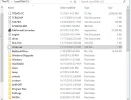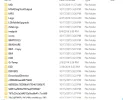Hi there,
Here's a link to an article that shows the minimal W10 folder configuration on a W10 bootable usb stick:
How To Create Bootable Windows 10 ISO From Files/Folders
That being said, we could use a little more information about the computer you are using here on W10. Is this a desktop PC or a laptop? Is it an OEM computer (Dell, HP, Acer, Toshiba, etc.)? Or is it a self-built PC or custom-built PC you built yourself from parts or paid a professional Tech to build for you? If it's an OEM computer, please provide us with Make/Model. If it's a self-built or custom-built PC, please provide Make/Model of your Motherboard, RAM memory sticks, GPU card, CPU chip, and PSU Make/Model/Wattage.
If you don't have this information handy, get as much as you can and you can download the free
SPECCY diagnostic program from piriform.com. Download
SPECCY and run it and post the result output text file back here for our further analysis.
Additionally, it's very important to know the exact date of manufacture of that XP computer you have. There are date limitations on how old the computer hardware can be in order so that it can run W10. Experimentally, several of us here on Windows Forum have determined that the oldest computer that can run W10 was made in 2006. That's 10 years ago. I personally have been testing W10 as an Insider Tester for Microsoft for over 2 years. During that time, I've tested XP-era machines that were built going back to 2002. None of these work. We do have 1 or 2 guys here that claim to have gotten an XP-era computer built in 2004 to work on W10; but it's unsubstantiated since he was not able to provide full specs on the machine nor it's BIOS build date. I've personally never seen one running W10 built prior to 2006, period. There are several ways to determine the build date; the BIOS is a good one, but is not always applicable as if you bought your computer used, a repair Tech may have updated it to several years newer, thus that build date in invalid. On OEM computers as I asked about above, they often have a Factory Sticker on the top, rear, or bottom of the tower case if a desktop PC, on the bottom of the laptop if a laptop and very rarely inside the battery compartment on the bottom of the laptop. This is much more reliable and the major computer makers such as Dell, HP, Acer, Gateway, Toshiba all use this; but if you got this computer used, or it was gifted to you, those stickers are often missing or torn off, or the numbers worn off from age and use. Again, that's why we asked for full specs on your computer.
I'm betting that if you did your own XP upgrade, you neglected to run the Microsoft
W10 COMPATIBILITY TEST, which tests for outdated hardware, apps, and drivers that do not work correctly in the W10 environment.

If you skipped this step, then you're not doing it right. Not checking this is like trying to get a computer like a 386 machine built back in the 80s to run W10; will never happen as those computers didn't meet the minimum specs required by W10 posted on the Microsoft website as well as the W10 install program.

Here's the link for the instructions on how to use the
W10 COMPATIBILITY TEST:
Get Windows 10 app - Check Compatibility Report for Windows 10
The fact that you got the AU update to install means that the hardware is probably pretty close to the cutoff date, otherwise it's highly unlikely that the AU would install at all.
Post back your information, and we can advise you further. But, this is my best guess at this point.
Best of luck to you,
 <<<BIGBEARJEDI>>>
<<<BIGBEARJEDI>>>
 Using a program such as mklink which neemo...
Using a program such as mklink which neemo... If you skipped this step, then you're not doing it right. Not checking this is like trying to get a computer like a 386 machine built back in the 80s to run W10; will never happen as those computers didn't meet the minimum specs required by W10 posted on the Microsoft website as well as the W10 install program.
If you skipped this step, then you're not doing it right. Not checking this is like trying to get a computer like a 386 machine built back in the 80s to run W10; will never happen as those computers didn't meet the minimum specs required by W10 posted on the Microsoft website as well as the W10 install program.




 There are other OEM files and folders built specifically for your Lenovo PC and inserted onto the C: drive folder structure. If you really wanted to see what files/folder should be on that C: drive from the factory, you're going to need to use the factory Recovery Discs that came with your PC. If you never got any, there may be a utility to make them. But on an 11 year old computer, it's not guaranteed to be there. You can call Lenovo to see if you can buy the factory Recovery Discs which will cost you $29-$99 US; but it's doubtful they have anything that old as Lenovo's were still being made in the US back then (they are now in China).
There are other OEM files and folders built specifically for your Lenovo PC and inserted onto the C: drive folder structure. If you really wanted to see what files/folder should be on that C: drive from the factory, you're going to need to use the factory Recovery Discs that came with your PC. If you never got any, there may be a utility to make them. But on an 11 year old computer, it's not guaranteed to be there. You can call Lenovo to see if you can buy the factory Recovery Discs which will cost you $29-$99 US; but it's doubtful they have anything that old as Lenovo's were still being made in the US back then (they are now in China). and without W10 chipset drivers and network drivers written by Lenovo for your PC, it's unlikely to ever run correctly.
and without W10 chipset drivers and network drivers written by Lenovo for your PC, it's unlikely to ever run correctly. Computers built in that era were made to last about 10 years; new computers today with the exception of Dell are only made to last 3-5 years. You've definitely gotten your money's worth from that old Lenovo. I would consider retiring it before it goes legs up on you. As you attempt to add various programs and apps to that W10 build, the more likely it will be that things won't work correctly, you'll start experiencing hang/freezes, BSODs and Black Screens, etc. The more stuff you do to try and make W10 work on it, the more likely it is to fail completely.
Computers built in that era were made to last about 10 years; new computers today with the exception of Dell are only made to last 3-5 years. You've definitely gotten your money's worth from that old Lenovo. I would consider retiring it before it goes legs up on you. As you attempt to add various programs and apps to that W10 build, the more likely it will be that things won't work correctly, you'll start experiencing hang/freezes, BSODs and Black Screens, etc. The more stuff you do to try and make W10 work on it, the more likely it is to fail completely. Again, sorry to be the bearer of bad news.
Again, sorry to be the bearer of bad news. <<<
<<<
 We tried doing stuff like this with various windows config rollouts to our national sales force and it exploded in our faces; the maintenance on a system like that is horrendous.
We tried doing stuff like this with various windows config rollouts to our national sales force and it exploded in our faces; the maintenance on a system like that is horrendous.